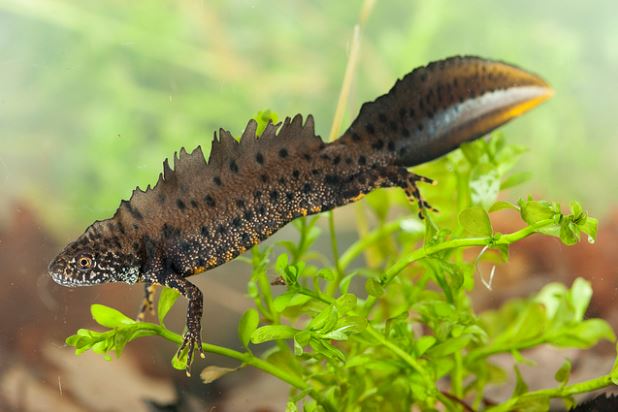Great Crested Newts Triturus cristatus are a protected amphibian species native to the United Kingdom and continental Europe. Their size can range from approximately 9cm to 19cm and can be identified by their characteristic black or dark brown rough (warty) skin and a stunning spotted orange underside. Males can be distinguished from females in the breeding season by a large, jagged crest and a white/silver flash along their tail, which is used in courtship displays.

Image shows a male Great Crested Newt in breeding condition, with characteristic jagged crest and tail flash. (c) Natural England 2019
Great Crested Newts rely on a variety of habitats. There is a common misconception they are only found in ponds, but the species actually spend most of the year in terrestrial habitats such as grassland, scrub, hedgerow bases, and woodland. These habitats include areas of dense vegetation and refugia (such as log piles and natural crevices), necessary for Great Crested Newts to forage, shelter, and hibernate over winter. The diet of a Great Crested Newt consists mainly of invertebrates and potentially other small amphibians. Juvenile Great Crested Newts will spend the first few years of their life on land until they reach sexual maturity and then return to ponds to breed each Spring.
Great Crested Newts rely on ponds with clean water and open margins but will also make use of poorer quality ponds if necessary. They use partially submerged marginal vegetation on which to lay their eggs, folding the leaves over individually to create an envelope concealing the egg from predators. They can be observed displaying in ponds in the breeding season ranging from March to June. The ideal newt pond should have access sunlight to allow for larval development and have connectivity to other ponds and terrestrial habitat nearby to facilitate movement between ponds and provide access to other areas of suitable habitat necessary throughout the year.
You can find more information regarding Great Crested Newts ecology in the GCN Conservation Handbook.
Why are Great Crested Newts important?
Great Crested Newts continue to suffer sharp declines that began in the twentieth century. Agricultural intensification, pollution, and increasing development pressure drastically reduce the quality and quantity of both terrestrial and aquatic habitats available to Great Crested Newts, as well as significantly reducing the connectivity of habitats and ponds across the landscape essential to dispersal, causing isolation of existing populations.
Great Crested Newts are a European Protected Species, they are protected against deliberate capture, killing, injury, and disturbance. It is also illegal to damage or destroy breeding and resting places used by the species. They are protected under the Wildlife and Countryside Act 1981 and the Conservation of Habitats and Species Regulations 2017.
The protections afforded under these items of legislation are cascaded into both national and local development policy such as Natural England Standing Advice, the ODPM Circular 06/2005, and Milton Keynes City Council’s adopted Local Plan, Plan: MK.
What do Milton Keynes City Council do to safeguard Great Crested Newts?
The Council has a dedicated Countryside Officer focussing on the conservation of Great Crested Newts across Milton Keynes. We advise planners and developers on consideration, mitigation, and enhancement for Great Crested Newts through the planning system and support local communities and Parishes with advice and habitat management recommendations.
Our work involves:
- screening planning applications to check for impacts Great Crested Newts, and habitats that may support the species
- providing advice to planners and developers on appropriate consideration of the species within the planning system
- working with partner organisations and landowners to identify and support opportunities for habitat restoration, creation, and enhancement
Milton Keynes City Council holds an Organisational District Licence for Great Crested Newts in partnership with NatureSpace. This licensing partnership is regulated by Natural England and allows us to assess and licence development projects that impact Great Crested Newts or their habitats. Development projects seeking to use this licence undergo independent assessment of their impacts and make an impact-proportionate financial contribution to the licensing scheme. These contributions are used to secure the delivery, management, and monitoring of expertly designed compensatory habitat through the creation and restoration of ponds and terrestrial habitat through the Newt Conservation Partnership.
The Newt Conservation Partnership are continually investigating opportunities for compensation sites across Milton Keynes. Milton Keynes City Council has now seen 13 ponds created or restored on Council land through the scheme, and has supported the Parks Trust, Wildlife Trust, Local Parishes, and private landowners to secure further habitat provision.
Great Crested Newts are widespread across Milton Keynes, and an up-to-date understanding of their range is essential to their conservation at both the local and national level. If you encounter a Great Crested Newt in your garden or elsewhere, please do not handle them, but consider submitting a record to the Buckinghamshire and Milton Keynes Environmental Records Centre.
District Licence and Biodiversity Net Gain (BNG)
Users of the District Licence scheme an also benefit from the integrated Biodiversity Net Gain package managed by NatureSpace and the Newt Conservation Partnership. More information on this can be found on the NatureSpace website.
Contacts
If you are a landowner interested in having a Great Crested Newt compensation pond dug on your land, please contact the Newt Conservation Partnership conservation officer. For all other Great Crested Newt enquiries, please contact MKCC's Countryside Officer.
